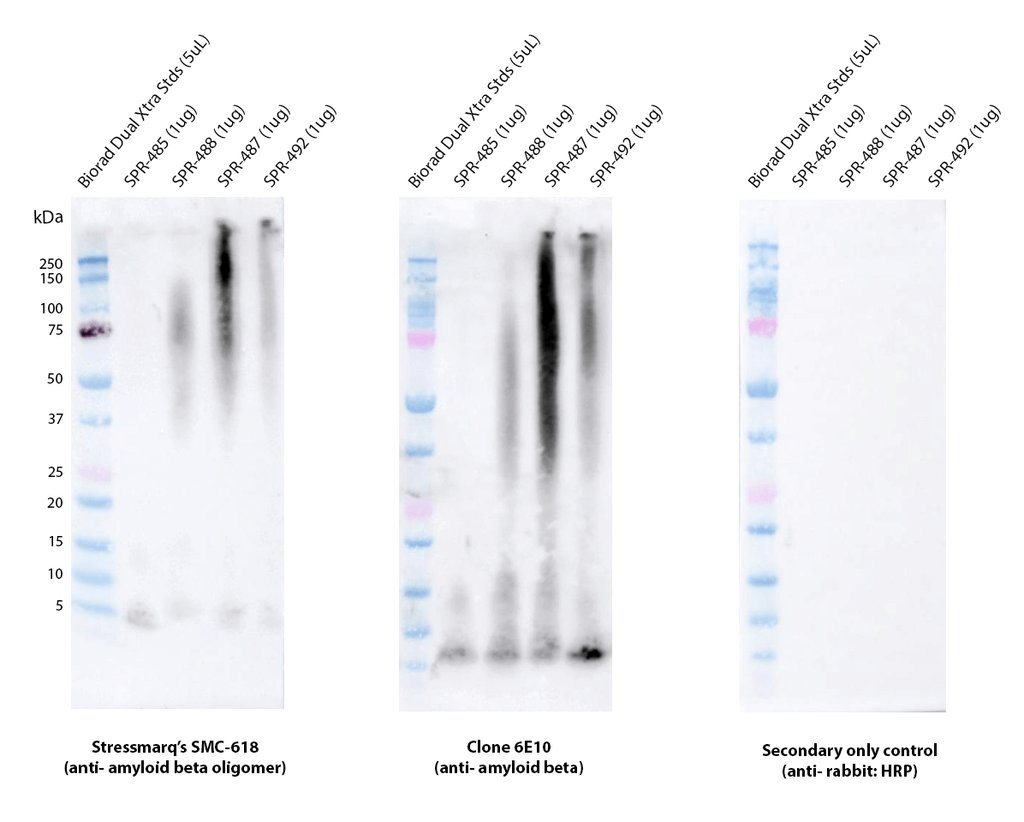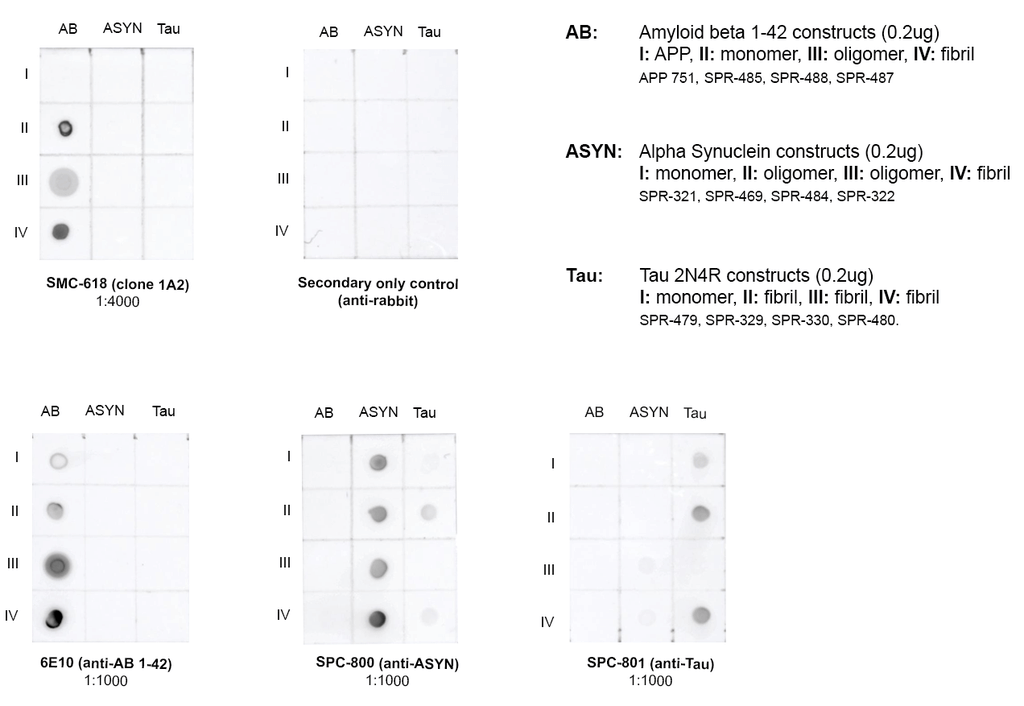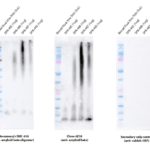Properties
| Storage Buffer | PBS pH 7.4, 50% glycerol, 0.09% sodium azide. *Storage buffer may change when conjugated |
| Storage Temperature | -20ºC |
| Shipping Temperature | Blue Ice or 4ºC |
| Purification | Protein A purified |
| Clonality | Recombinant Monoclonal |
| Clone Number | 1A2 |
| Isotype | IgG |
| Specificity | Amyloid Beta 1-42 oligomers |
| Cite This Product | Rabbit Anti-Human Amyloid Beta 1-42 Oligomer Recombinant Monoclonal (StressMarq Biosciences, Victoria BC, Cat# SMC-618) |
| Certificate of Analysis | A 1:4000 dilution of SMC-618 was sufficient for detection of 2ng of AB 1-42 oligomers by dot blot analysis with goat-anti-rabbit:HRP as the secondary and by self-sandwich ELISA analysis (capture at 1 ug/mL, detection at 0.2 ug/mL). |
Biological Description
| Alternative Names | Abeta Oligomers Antibody, APP Antibody |
| Research Areas | Alzheimer's Disease, Amyloid, Neurodegeneration, Neuroscience |
| Cellular Localization | Membrane (Secreted) |
| Gene ID | 351 (APP) |
| Swiss Prot | P05067 |
| Scientific Background | Our amyloid beta oligomer antibody has been tested for specificity against AB 1-42 aggregates, with higher specificity to oligomers demonstrated. In the brain, amyloid beta peptide (Aβ) is generated by protease cleavage of amyloid precursor protein (APP), which aggregates into oligomers, protofibrils, fibrils and ultimately plaques in neurodegenerative diseases. The accumulation of Aβ plaques in the brain is considered a hallmark of Alzheimer’s disease (AD), and most of the drugs tested for AD in the past 20 years have targeted amyloid beta accumulation (1). The immunogen used was our Amyloid Beta 1-42 (Aβ42) Oligomers are generated from Amyloid Beta Peptide 1-42 pre-treated with 1,1,1,3,3,3-Hexafluoro-2-propanol (HFIP) as previously published (2,3). |
| References |
1. Panza et al. 2019. Nat Rev Neurol. 15:73-88 https://doi.org/10.1038/s41582-018-0116-6 2. Stine et al. 2003. JBC. 278(13):11612-22. doi: 10.1074/jbc.M210207200 3. Ahmed et al. 2010. Nature Structural & Molecular Biology. 17(5):561 doi: 10.1038/nsmb.1799 |
Product Images

Western blot analysis comparing detection of StressMarq’s Amyloid Beta 1-42 constructs (SPR-485 = amyloid beta 1-42 peptide; SPR-488 = amyloid beta 1-42 oligomers; SPR-487 = amyloid beta 1-42 pre-formed fibrils; SPR-492 = amyloid beta pyroglutamate 3-42 pre-formed fibrils). Block: 5% skim milk. Primary Antibodies: Rabbit Anti-Amyloid Beta 1-42 oligomer monoclonal antibody (SMC-618, clone 1A2) & Mouse Anti-Amyloid Beta 1-16 monoclonal antibody (Biolegend 803001, clone 6E10), both at 1:1000 for 1/2 hour at RT. Secondary Antibodies: Goat anti-rabbit IgG:HRP or anti-mouse IgG:HRP at 1:4000 for 1/2 hour at RT. Color Development: Chemiluminescent for HRP (Moss) for 1 min in RT. Exposed 1 second.

Dot blot analysis comparing detection of StressMarq’s amyloid beta 1-42 constructs, alpha synuclein wildtype constructs, and tau constructs. Of note is that SMC-618 does not bind APP 751 or other protein constructs such as alpha synuclein and tau. Block: 5% skim milk. Primary Antibodies: Anti-Amyloid Beta 1-42 oligomer monoclonal antibody (SMC-618, clone 1A2), Anti-Amyloid Beta 1-16 monoclonal antibody (Biolegend 803001, clone 6E10), Anti-Alpha Synuclein polyclonal antibody (SPC-800), and Anti-Tau polyclonal antibody (SPC-801), all incubated for 1/2 hour at RT. Secondary Antibodies: Goat anti-rabbit IgG:HRP or anti-mouse IgG:HRP at 1:4000 for 1/2 hour at RT. Color Development: Chemiluminescent for HRP (Moss) for 1 min in RT. Exposed 1 second.

Dot blot analysis comparing detection of StressMarq’s amyloid beta constructs. Concentrations tested are 20 & 2ng, respectively. Block: 5% skim milk. Primary Antibodies: Rabbit Anti-Amyloid Beta 1-42 oligomer monoclonal antibody (SMC-618, clone 1A2) & Mouse Anti-Amyloid Beta 1-16 monoclonal antibody (Biolegend 803001, clone 6E10), both at 1:1000 for 1/2 hour at RT. Secondary Antibodies: Goat anti-rabbit IgG:HRP or anti-mouse IgG:HRP at 1:4000 for 1/2 hour at RT. Color Development: Chemiluminescent for HRP (Moss) for 1 min in RT. Exposed 1 second.


![Rabbit Anti-Amyloid Beta 1-42 Oligomer Antibody [1A2] used in ELISA (ELISA) on Human Purified protein (SMC-618)](https://www.stressmarq.com/wp-content/uploads/SMC-618_Amyloid-Beta-1-42-Oligomer_Antibody_1A2_ELISA_Human_Purified-protein_1.png)




















Reviews
There are no reviews yet.